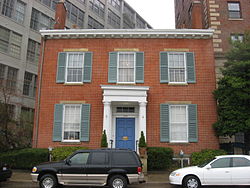
George Grey Barnard, often written George Gray Barnard, was an American sculptor who trained in Paris. He is especially noted for his heroic sized Struggle of the Two Natures in Man at the Metropolitan Museum of Art, his twin sculpture groups at the Pennsylvania State Capitol, and his Lincoln statue in Cincinnati, Ohio. His major works are largely symbolical in character. His personal collection of medieval architectural fragments became a core part of The Cloisters in New York City.

William Howard Taft National Historic Site is a historic house at 2038 Auburn Avenue in the Mount Auburn Historic District of Cincinnati, Ohio, a mile (1.6 km) north of Downtown. It was the birthplace and childhood home of William Howard Taft, the 27th president and the 10th chief justice of the United States. It is a two-story Greek Revival house built circa 1845.

Cincinnati began with the settlement of Columbia, Losantiville, and North Bend in the Northwest Territory of the United States beginning in late December 1788. The following year Fort Washington, named for George Washington, was established to protect the settlers.
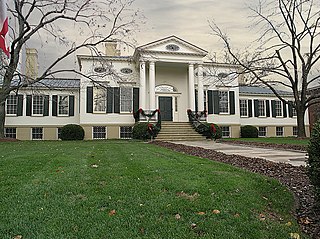
The Taft Museum of Art is a fine art collection in Cincinnati, Ohio. It occupies the 200-year-old historic house at 316 Pike Street. The house – the oldest domestic wooden structure in downtown Cincinnati – was built about 1820 and housed several prominent Cincinnatians, including Martin Baum, Nicholas Longworth, David Sinton, Anna Sinton Taft and Charles Phelps Taft. It is on the National Register of Historic Places listings, and is a contributing property to the Lytle Park Historic District.

Spring Grove Cemetery and Arboretum is a nonprofit rural cemetery and arboretum located at 4521 Spring Grove Avenue, Cincinnati, Ohio. It is the third largest cemetery in the United States, after the Calverton National Cemetery and Abraham Lincoln National Cemetery and is recognized as a US National Historic Landmark.

Western & Southern Financial Group, also commonly referred to as Western & Southern, is a Cincinnati, Ohio-based diversified company of financial services subsidiaries with $111.6 billion in assets owned and managed as of December 2021. As of 2022, it held a "AA- Very Strong" rating from Standard & Poor's, a "A+ Superior" from A.M. Best, a "AA Very Strong" from Fitch, a "Aa3 Excellent" from Moody's, and a "96 out of 100" Comdex ranking.

The Lytle Tunnel is a vehicular tunnel that carries Interstate 71 (I-71) under the historic Lytle Park in Cincinnati, in the U.S. state of Ohio, connecting Fort Washington Way to the Northeast Expressway. It is a six-lane tunnel with three tubes. There is a two-lane southbound tube, a three lane-northbound tube, and a one-lane southbound tube that separates from the highway and serves as an exit ramp to the downtown area. The tunnel is ventilated by two grates in the northbound tube and the southbound exiting tube. It was completed in 1970. At 335 meters, it is the longest vehicular tunnel in Ohio. It is also the only tunnel on I-71.
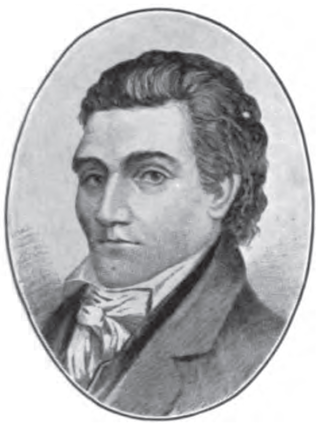
Martin Baum was an American businessman and politician.
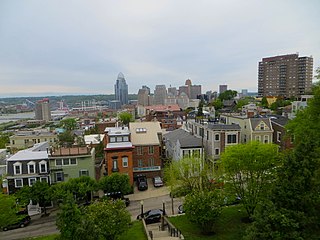
Mount Adams is a geographic landmark and residential neighborhood of Cincinnati, Ohio, located directly east of downtown Cincinnati, south of Walnut Hills, southwest of East Walnut Hills, and west of the East End.

The Literary Club of Cincinnati is located at 500 East Fourth Street, across from Lytle Park in downtown Cincinnati, Ohio. The club occupies a two-story Greek Revival house which was built in 1820, on the site of the home of William Sargent, secretary of the Northwest Territory. The Club was founded in 1849; its membership is limited to 100 men.
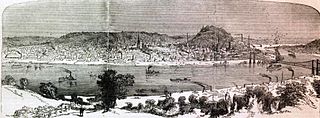
During the American Civil War, the Ohio River port city of Cincinnati, Ohio, played a key role as a major source of supplies and troops for the Union Army. It also served as the headquarters for much of the war for the Department of the Ohio, which was charged with the defense of the region, as well as directing the army's offensives into Kentucky and Tennessee.

The Gorham A. Worth House is a historic residence in the Mount Auburn neighborhood of Cincinnati, Ohio, United States. Located atop a hill along Auburncrest Avenue, the house was built in 1819 in a version of the Federal style of architecture.

Eden Park is an urban park located in the Walnut Hills neighborhood of Cincinnati, Ohio. The hilltop park occupies 186 acres (0.75 km2), and offers numerous overlooks of the Ohio River valley.

Downtown Cincinnati is the central business district of Cincinnati, Ohio, United States, as well the economic and symbiotic center of the Cincinnati metropolitan area. It also contains a number of urban neighborhoods in the low land area between the Ohio River and the high land areas of uptown. These neighborhoods include Over-the-Rhine, Pendleton, Queensgate, and West End.

Frederick W. Garber was an American architect in Cincinnati, Ohio and the principal architect in the Garber & Woodward firm with Clifford B. Woodward (1880–1932). The firm operated from 1904 until it was dissolved in 1933 Their work has been described as in the Beaux-Arts tradition and included buildings on the University of Cincinnati campuses, schools, hospitals, commercial buildings, "fine residences" and public housing.
Guilford School is a historic former schoolhouse, now housing commercial offices, on the east side of Downtown Cincinnati at 421 E 4th Street. The building is adjacent to Lytle Park is a contributing property to the Lytle Park Historic District.

Rudolph Tietig (1877-1958) was an architect in Cincinnati, Ohio, United States and a partner in the Tietig & Lee architectural firm with Walter H. Lee (1877-1952).

An 11-foot (3.4 m) bronze statue of Abraham Lincoln is installed in Lytle Park within downtown Cincinnati, Ohio, United States.
